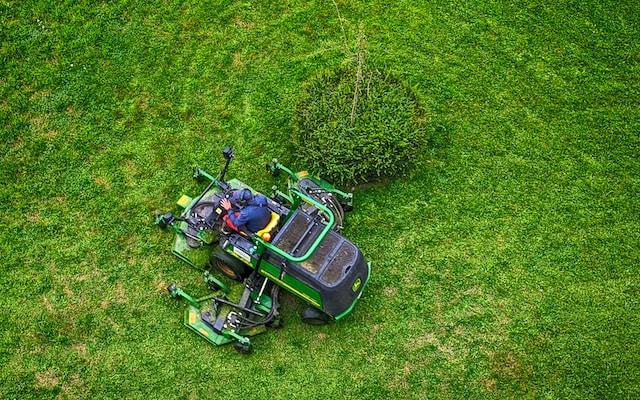While you and your family walk and play on your lawn during the summer months, the grass may begin to thin out in some areas. While aerating the lawn to invigorate the root system of the grasses is a widespread technique, it takes time, and the lawn can appear awful for several weeks.
You can overseed your lawn without aerating it if it simply needs extra grass.
While you can overseed lawns early in the spring before the grass starts to grow, sowing grass seed late in the growing season, before the first frost, is the optimal time.
It’s a fascinating process with numerous advantages. It is the quickest way to increase grass density, may be used to cover thin sections in your lawn, and improves the appearance of your yard. Overseeding is ideal if you want to try out different species of grasses.
Table of Contents
Why Do You Need To Aerate The Lawn?
Poking holes in your lawn’s surface to allow air to move more freely is known as aeration. By loosening the soil, it can also make it easier for water and nutrients to reach the roots of your lawn. As a result, it aids the germination and growth of your lawn seedlings.
Although aeration is necessary for the health of your grass, it is time-consuming. It can also be costly, mainly if an aerator must be purchased or rented. Because overseeding isn’t required, you can develop a thicker lawn using a variety of approaches.
The issue with aeration is that it necessitates expensive equipment, a significant amount of time, and careful watering.
Because you’re effectively digging in numerous tiny holes into your yard, you should also mark off and be mindful of inground sprinklers and utility wires. You don’t want to run over anything in your yard that is buried shallowly!
Importance Of Overseeding Your Lawn
Overseeding refers to the practice of sowing new lawn seeds on top of existing turf. During this process, you do not remove the prior grass or turn the soil. This procedure can fill up any gaps in your grass, giving it a more attractive appearance and boosting its health.
If you are a new tenant or property owner, you may need to overseed your lawn. If the previous household neglected their lawn, it might have unsightly holes or thin spots throughout the surface. Overseeding can also aid in the transition from one lawn type to the next.
Steps To Overseed The lawn Without Aerating
Don’t worry; if you don’t have expensive tools and equipment to aerate your lawn. You can also overseed the lawn even without aerating by following the mentioned points and steps efficiently.
1) Prepare The Lawn With Lawnmower
Mow your existing lawn with your lawnmower. You want it to be around 1 to 2 inches tall when you cut it. Cutting your grass short is critical because it prevents weeds and existing turf competing for nutrients and water with new seeds. It also allows sunlight to pass through the surface, reach the soil, and aid in the growth of the seeds.
Finally, it will allow the seeds to reach the ground without being stuck in the grass. During this operation, make sure your lawnmower is equipped with a grass bag. Mulching the lawn and letting it sit on the surface goes against logic because it prevents the seeds from reaching the ground.
2) Determine The Best Season For Overseeding
It’s critical to understand when the optimal time is to sow grass. If you want the most satisfactory results for your grass, you need to plant it in each region at a specified time of year.
Even though this is only overseeding, you don’t want to lose time by selecting the incorrect month and allowing the seeds to be blown away or eaten by birds before germinating.
Choose grass seed that matches what you have on your lawn. It’s best not to combine too many grass seeds because they could not be compatible. Rather than pasture grasses, choose turf grasses.
3) Use A Metal Rake To Loosen The Soil
You’ll need to loosen the soil with a metal thatching rake or dethatcher because you’re not aerating. Drag your rake across the earth’s surface. You want to remove the thatch, made up of dead plants, grass clippings, and other debris, as thoroughly as possible.
You can either rake afterward or cut with a bag. Overseeding will be ruined if you have clippings in your grass. Because you won’t be cutting the grass again until the new seeds have taken root, you’ll want it to be relatively low. So, you can wait more than two weeks before cutting it again.
4) Seed Manually Or Using A Spreader
Now, you are all set to seed to oversee the lawn. You can use your hand, a broadcast spreader, or a drop spreader to spread the message. When compared to seeding a new lawn, every spreader will come with recommendations for the optimal setting for overseeding.
But, in the end, it’s up to you how many seeds you sow and how you disseminate them. The more seeds you disperse, the better your chance of germination.
Refill the seed spreader with the remaining seed. Push the spreader around the perimeter in the opposite direction. Like in the previous step, walk back and forth with the spreader, but make rows at right angles to the initial pass.
5) Settle The Seeds Into The Soil
Reapply your rake, but this time more softly. This phase allows the seeds to settle into the soil, preventing them from being eaten by birds or washed away by water. However, be careful not to rake too vigorously. You run the danger of scattering the seeds, resulting in gaps or too many in one location.
To prevent this problem, you might want to rake in all directions. It’s the most straightforward method and requires no special equipment. If you want to boost your chances, cover the area you’re seeding with topsoil.





